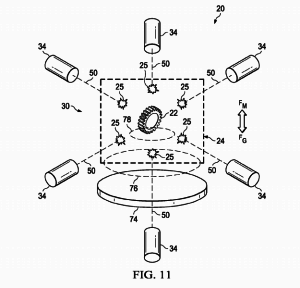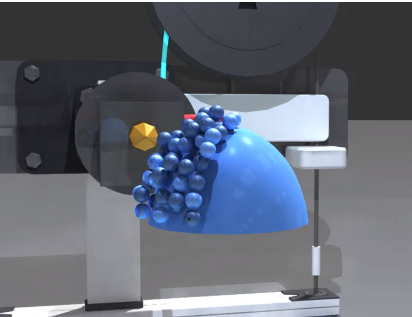 I always love seeing new 3D printing patent applications. There has been some wacky-looking stuff presented — Samsung’s recently granted patent for a holographic 3D printer comes to mind — but I’ve never seen anything like the technology Boeing has come up with. The aerospace giant has recently filed a patent application for a process that 3D prints levitating objects. Yes, levitating objects.
I always love seeing new 3D printing patent applications. There has been some wacky-looking stuff presented — Samsung’s recently granted patent for a holographic 3D printer comes to mind — but I’ve never seen anything like the technology Boeing has come up with. The aerospace giant has recently filed a patent application for a process that 3D prints levitating objects. Yes, levitating objects.
It seems ludicrous. Multiple 3D printer heads shoot material at a magical floating nugget that collects the material, layer by layer, and grows into, apparently, an airplane part. I can’t wrap my head around it, but Boeing is very serious. The proposed technology is called “Free-Form Spatial 3-D Printing Using Part Levitation,” and it involves a “nugget” (yes, that is in fact the scientific term) made of printed material that is suspended in space via magnetic fields. Several printer heads surround said nugget and deposit additional printing material onto it from all sides.
“There is a need for an Additive Manufacturing (AM) method and apparatus that eliminates the need for a platform and/or support materials to stabilize the part during the fabrication process, and which removes limitations on the types of features that can be formed, allowing full body 3D printing of complex parts,” Boeing states.
 The magnetic fields also allow the object to be rotated in space, so that material can be added to the bottom as well. The patent application actually proposes several possible methods of levitating the object. Most of them involve the manipulation of magnets, for example: “…supercooling the part until the part becomes a superconductor, and subjecting the part to a magnetic field producing a magnetic force that is substantially equal to a gravitational force, and trapping the part within the node.”
The magnetic fields also allow the object to be rotated in space, so that material can be added to the bottom as well. The patent application actually proposes several possible methods of levitating the object. Most of them involve the manipulation of magnets, for example: “…supercooling the part until the part becomes a superconductor, and subjecting the part to a magnetic field producing a magnetic force that is substantially equal to a gravitational force, and trapping the part within the node.”
 So simple, no? Another proposed method of levitation involves generating acoustic waves so powerful that they force the nugget into the air; it’s then held in the air by an acoustic reflector that reflects the sound waves and creates a “standing wave pattern” that keeps the part in place while the print heads do their thing. Those multiple print heads, by the way, should make the printing process incredibly fast. And the fact that there’s no build plate means that there’s no limit on the size of objects can be printed. Boeing, being an aircraft manufacturer, obviously proposes using this system to built aircraft parts, or, it appears, even entire airplanes. As the patent application states:
So simple, no? Another proposed method of levitation involves generating acoustic waves so powerful that they force the nugget into the air; it’s then held in the air by an acoustic reflector that reflects the sound waves and creates a “standing wave pattern” that keeps the part in place while the print heads do their thing. Those multiple print heads, by the way, should make the printing process incredibly fast. And the fact that there’s no build plate means that there’s no limit on the size of objects can be printed. Boeing, being an aircraft manufacturer, obviously proposes using this system to built aircraft parts, or, it appears, even entire airplanes. As the patent application states:
“…The aircraft produced by exemplary method may include an airframe with a plurality of systems and an interior. Examples of high-level systems include one or more of a propulsion system, an electrical system, a hydraulic system, and an environmental system. Any number of other systems may be included.”
I’m not even going to begin to think about the logistics of it all, but it’s really a brilliant proposal. If it comes to fruition and doesn’t disappear into the vast black hole of patent applications, it could be used for any number of industries. 3D printing is already a technology that has done away with many of the limitations of traditional manufacturing, but this process could do away with the limitations of traditional 3D printing. And that would mean a technology that is, well, limitless. You can read the entire patent application here, and Patent Yogi has kindly put together a video to help you visualize how this technology would work. See below. Were you surprised to hear about this? Discuss in the 3D Printed Levitating Object forum over at 3DPB.com.
Subscribe to Our Email Newsletter
Stay up-to-date on all the latest news from the 3D printing industry and receive information and offers from third party vendors.
You May Also Like
Gorilla Sports GE’s First 3D Printed Titanium Cast
How do you help a gorilla with a broken arm? Sounds like the start of a bad joke a zookeeper might tell, but it’s an actual dilemma recently faced by...
Nylon 3D Printed Parts Made More Functional with Coatings & Colors
Parts 3D printed from polyamide (PA, Nylon) 12 using powder bed fusion (PBF) are a mainstay in the additive manufacturing (AM) industry. While post-finishing processes have improved the porosity of...
$25M to Back Sintavia’s Largest Expansion of Metal 3D Printing Capacity Since 2019
Sintavia, the digital manufacturing company specializing in mission-critical parts for strategic sectors, announced a $25 million investment to increase its production capacity, the largest expansion to its operations since 2019....
Velo3D Initiates Public Offering in a Bid to Strengthen Financial Foundations and Drive Future Growth
Velo3D (NYSE: VLD) has been among a number of publicly traded 3D printing firms that have attempted to weather the current macroeconomic climate. After posting a challenging financial report for 2023,...
































